24 Mt. Hood Community College
Heather White
Oregon
Type of Institution: Community college
Impetus: Oregon House Bill 2871
Student Information System: Jenzabar (JICS user portal; CX staff interface)
Markings Used: No Cost: $0 and Low Cost: Under $50
Unique Features: Creation of a course section reporting form for instructors
Introduction
Mt. Hood Community College (MHCC) is a small institution of under 8,000 full-time equivalent (FTE) students, run on a quarter system. MHCC is located 30 minutes outside of Portland, Oregon, in the city of Gresham. In July 2015, the Oregon legislature passed House Bill (HB) 2871, which established a statewide mandate for all publicly funded universities and community colleges to “prominently designate courses whose course materials exclusively consist of open or free textbooks or other low-cost or no-cost course materials” at the point of course registration. The legislators allowed each institution the flexibility to determine their own implementation strategy. This case study outlines how MHCC came into compliance by Fall 2017, how our work evolved over the first two years of implementation, and how we navigated the complexities of implementing new policies and procedures in a large organization with multiple stakeholders.
In 2015, few schools in Oregon had a student information system (SIS) with existing functionality to enable the course markings required by this new law. Five schools used a Jenzabar SIS: Klamath Community College, Southwestern Oregon Community College, Tillamook Bay Community College, Treasure Valley Community College, and MHCC. All five schools used Jenzabar JICS as their student and instructor portal; our colleagues used Jenzabar JX for their staff interface, while MHCC used the slightly more archaic CX. These three Jenzabar software programs—JX, CX, and JICS—lacked the necessary functionality to manifest the HB 2871 mandated course markings, much less make them searchable by users.
Amy Hofer, Oregon’s Coordinator of Statewide Open Education Library Services at Open Oregon Educational Resources, was integral in helping our institutions reach compliance. In Fall 2016, she gathered all the Jenzabar schools for a group brainstorming session. We quickly realized that without software enhancement we would be unable to comply with HB 2871. Under Open Oregon’s leadership, key representatives from each institution met with Jenzabar representatives and explained our needs. Acting separately, each of us would have faced our own software enhancement fee—a considerable expense—but negotiating as a collective under a state legislative mandate, we were able to work with Jenzabar to arrive at a rather good deal: one software enhancement fee of $15,000, split across all five institutions in exchange for building out the necessary course marking and search functionality for each of us. Open Oregon proposed a model in which each school paid proportionally according to FTE. As the largest school by FTE, MHCC gladly accepted the largest share, which we believed to be the most equitable solution.
Jenzabar completed their work within two weeks. They created a new field in CX and JX to enable the course markings on individual course sections. A new column in JICS displayed the course markings. The search functionality added in JICS enabled students to limit their search by the course markings. Afterward, each school individually planned their own implementation according to local needs.
Implementation
MHCC already had an active Textbook Affordability Team (TAT; Mt. Hood Community College 2020b), created following a keynote address from Dr. Cable Green, Creative Commons’ Director of Open Education, at In Service for Fall 2015. TAT members included college instructors, librarians, bookstore staff (college owned and operated), deans, student government officers, and the college president. In Fall 2016, the TAT formed a subcommittee to handle HB 2871 course designations. This subcommittee included the textbook buyer from the bookstore, the instructional scheduling and resource analyst, myself (as the library technical services and open educational resources (OER) coordinator and co-chair of the TAT), Information Technology’s (IT) Jenzabar system administrator, a computer programmer, and the director of infrastructure and application support.
When considering course designations, we asked ourselves a few basic questions:
- How do we find out which course sections should receive which designations?
- Should we differentiate between OER and No Cost?
- How do we define Low Cost?
- How do we automate the course marking in our course schedule?
- How do we inform instructors?
- How do we inform students?
- And how do we gather data to provide meaningful statistics over time?
The only people who could tell us which course sections should receive which designations were the instructors choosing the textbooks. Though the bookstore already has some of this information centralized and could export the data, importing their data into the SIS (CX) and displaying it in the course schedule (JICS) is impossible as the software programs are not interoperable. Furthermore, textbook orders sometimes come in late or change when instructor assignments change. Some instructors do not assign textbooks at all and, as a result, do not communicate with the bookstore. Therefore, this workflow had to start with instructors, and we saw this as an opportunity to empower them to take control of the rising costs of textbooks.
The TAT has worked with MHCC’s student government association (SGA) from the very start. Student representatives were asked for their preferences and insights about course markings—for example, whether open-source materials should be identified and what “low cost” means to students. After deliberating through their formal senate hearings, the SGA asked for just two designations: “Low Cost: Under $50” and “No Cost: $0.” They requested that we not designate OER specifically. They preferred the label “Textbook Price” on the column where the course markings would be displayed (see fig. 24.1), and, in the search drop-down menu, they requested “None Specified” to indicate no limiter had been set (see fig. 24.2).

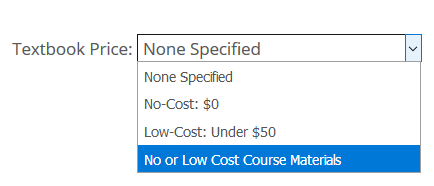
First Course Section reporting Form Iteration (2017)
To facilitate reporting and publishing of course markings, the TAT created a web form that instructors fill out to automatically mark their course sections as either No Cost or Low Cost. Our computer programmer built this Course Section Reporting Form (CSRF) from scratch using C#, ASP.NET, Javascript, HTML, and CSS, and our Jenzabar system administrator configured an application programming interface (API) to automatically map instructors’ inputs into CX, to be displayed and searchable for students in the online Course Schedule (JICS) at the point of registration, thus bringing us into compliance with HB 2871.
Instructors find the CSRF by logging into their MyMHCC portal (JICS). The form automatically lists the course sections assigned to the person who is logged in. Course section assignments are updated automatically over time, so the upcoming term’s course sections are ready for marking a few weeks before registration opens. See figure 24.3.
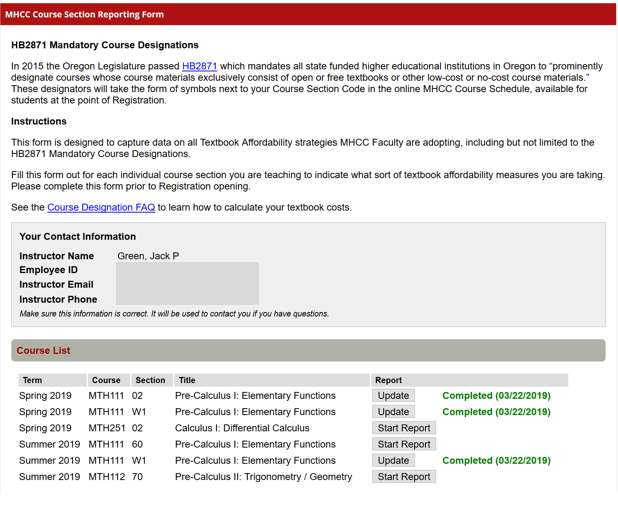
Instructors fill out the CSRF section by section, term by term, for each section they teach, prior to online registration opening for each term. Once they fill it out, the online course schedule Textbook Price column automatically displays No Cost or Low Cost designations (see fig. 24.1). If instructors need to change the designation on a course (e.g., to correct a mistake or take over a section from a different instructor), they fill the form out again and the most recent entry will overwrite the previous entry. The MHCC CSRF provides a section on Frequently Asked Questions (FAQ; Mt. Hood Community College 2020a), including on how to calculate course material costs; guidance on this question was derived from Portland Community College’s comparable CC-BY FAQ, also written to comply with Oregon HB 2871.
As Library Technical Services and OER Coordinator, I worked with our computer programmer, and together we developed the bulk of the CSRF design. We met with five instructor beta testers and revised the question structures and form functionality based on their feedback. Initially, we wanted the questions to serve as a change management tool, to guide our instructors into a new way of thinking. We wanted them to start considering what the total cost of their courses were, beyond tuition and fees. We also wanted them to pay attention to what kinds of copyright licenses govern the use of their course materials (see fig. 24.4 and fig. 24.5).
The first CSRF question generates the No Cost and Low Cost markings in our course schedule, and it only does this if instructors answer either “Completely Free!” or “$1-$49,” respectively. While we do not mark anything beyond these cost thresholds in the Course Schedule, we gather data on which course sections are using OER regardless of HB 2871 and which course sections have an expensive textbook that is used for multiple terms over a sequence of courses.
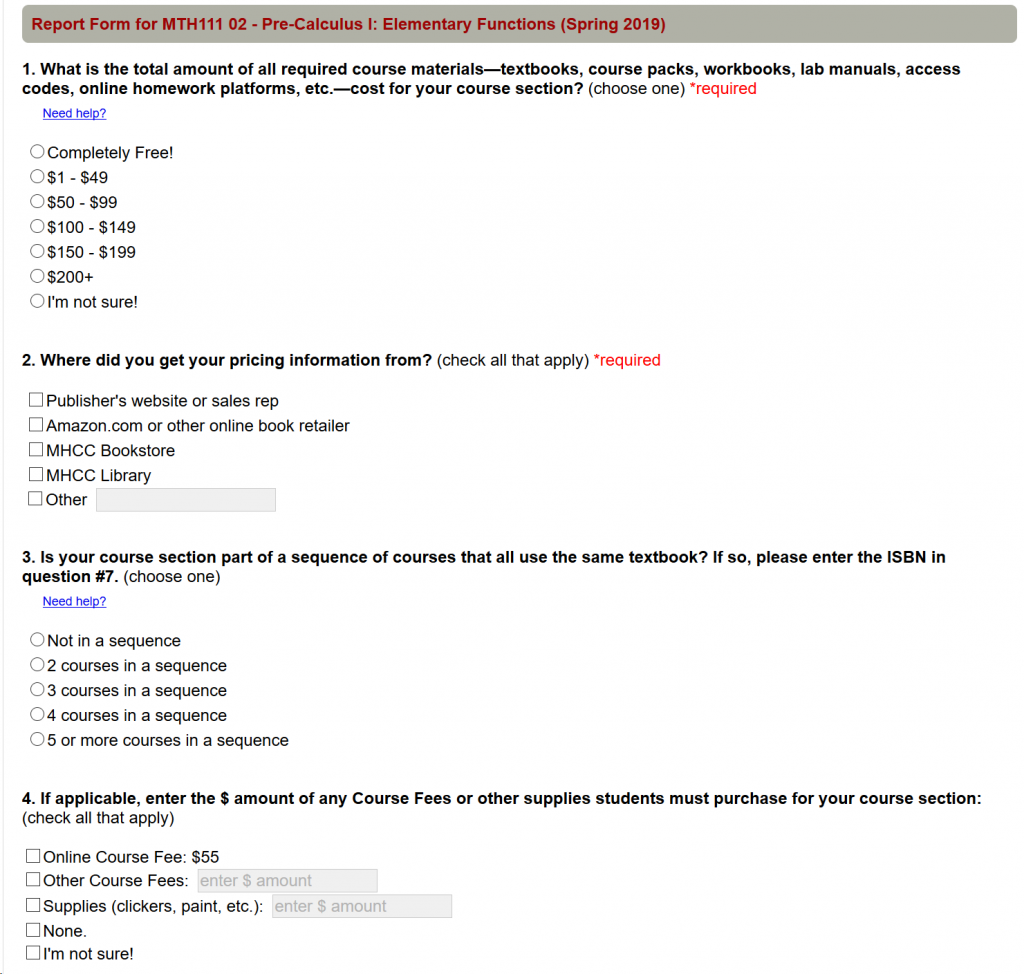
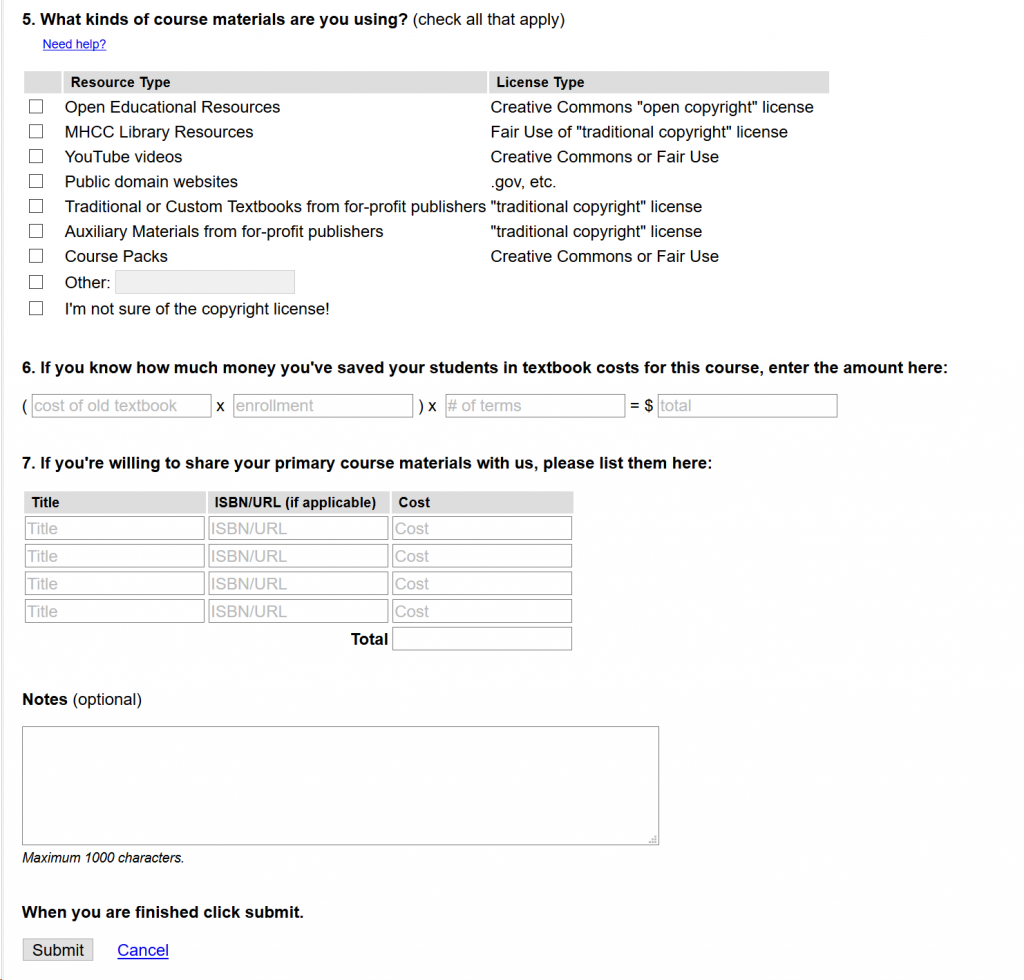
We implemented this first version of the form in early July 2017. Unfortunately, the majority of instructors had already left campus for summer break, not to return until the end of August. As a result, we did a soft launch over Summer term and worked with our college marketing department to get ready for a CSRF debut in time for Fall 2017.
Marketing to instructors and Students
Our marketing team designed a flyer for Fall 2017 In Service (fig. 24.6) as well as posters (fig. 24.7) and postcards (fig. 24.8) informing students of the new course markings. Our director of infrastructure and application support and I co-presented on the CSRF at an In Service break out session, and I later explained the form in more detail at a Faculty Senate meeting. We put up the student posters around campus, and the postcards went into the New Student Welcome bags and were distributed at relevant service points, such as the front desks at the student union, registration and advising, and the library.
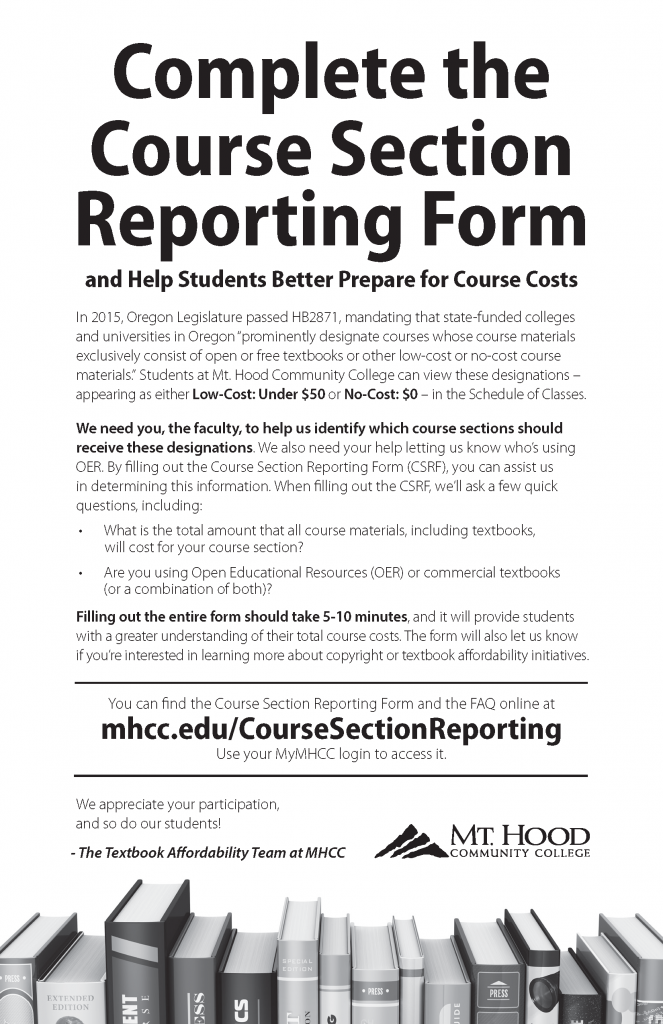

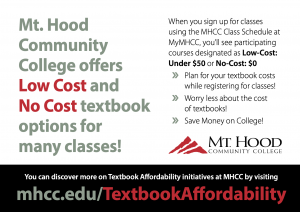
I received a variety of feedback through emails and face-to-face comments. Some instructors readily filled out the CSRF with expressions of gratitude for making college more affordable for students. Other instructors were not used to dealing with any logistics about their textbooks—they used the same books chosen by their colleagues, and their departmental administrative assistants placed orders with the bookstore. For these instructors, filling out the CSRF was a new step that they struggled to integrate into their routine course preparation. A few instructors expressed feeling guilt over not already using low-cost textbooks, while others felt trapped by publishers who they perceived as price gouging their students because suitable OER replacements for their expensive textbooks were not available. A very small number of instructors anchored their teaching methods to a specific, high-cost textbook, and they did not want to be pressured into using perceived subpar content.
Providing timely reminders to instructors to fill out the CSRF term to term, year to year, has proven critical but surprisingly difficult to coordinate. Instructors’ reporting rates correlated closely with whether email reminders were sent. From the start, the bookstore included a link to the CSRF in all their emails requesting textbook orders, but this alone has not been enough. In the Fall of 2018 when our marketing focus shifted to students, we did not have the staffing model to provide additional email reminders. While some instructors remembered on their own, our reporting rates were low compared with the previous year. This speaks to the need for sustainable staffing models of OER programs. At first, the TAT thought someone in scheduling or registration should send reminder emails to instructors as an official duty of their department, since these personnel are plugged into rotating registration dates and course markings could be considered a student service; then we thought perhaps staff in instructional services should do it because reporting cost savings could be considered an instructional service. In the Spring of 2019, after I returned from the Open Textbook Network’s Certificate of OER Librarianship training, we decided that I would send these reminder emails, as I am increasingly well known among our instructors as their OER coordinator. I set up a schedule to send email reminders 1 week before the course schedule goes live for viewing, and after the Drop/Add period ends, to catch any last-minute instructor changes. With these routine, well-timed email reminders, our reporting numbers increased and stabilized.
In Fall 2018, the TAT’s SGA representative reported that the posters and postcards we continued to distribute were not enough—that many students had told him they were unaware of the course markings. This industrious and highly motivated student leader had the idea of making a video tutorial on how to find courses with No Cost and Low Cost markings. Our online learning department and my TAT co-chair helped him with the software and video editing, and the tutorial debuted during the 2019 Open Education Week (Mt. Hood Community College 2019; see fig. 24.9).
Figure 24.9: Tutorial on identifying low-cost and no-cost textbooks on the course schedule
This video is linked from our course registration page, and our marketing department plans to share it out through social media channels during all registration periods moving forward. We expect this will also help the TAT onboard new student government officers year after year.
Data Collection & Analysis
Our computer programmer built a back-end reporting tool in JICS for the admin portal of the CSRF to generate CSV reports at any time for any date range (see fig. 24.10). Logins to the CSRF Data Export tool were given to myself and MHCC’s institutional research staff, who use the data to generate meaningful statistics for internal and external stakeholders.
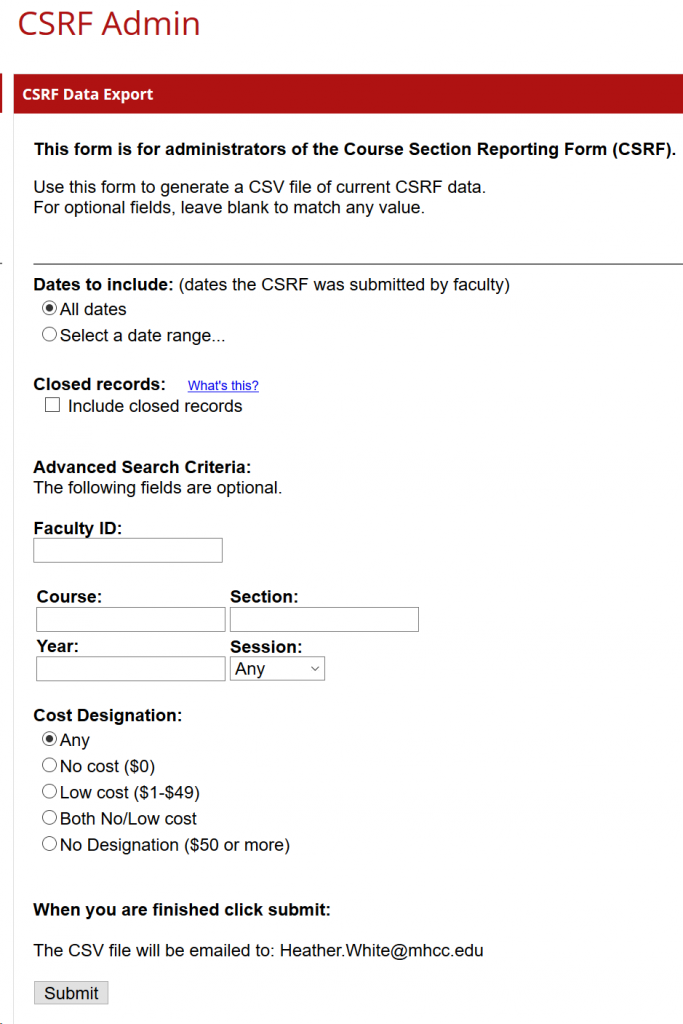
For example, the CSRF data export tells me that between Summer 2017 and Spring 2018, 75 instructors reported using alternative resources in their courses. Our analytics and institutional research department used CSRF data and the emerging best practice to use a $100 No Cost/$75 Low Cost multiplier method to calculate that students had saved over $1 million between Summer 2017 and Spring 2019. That figure is likely low, as many instructors are still getting used to filling out the CSRF. While there is no incentive for filling out the form, instructors are generally willing to do it when reminded and given a convenient link to click on.
Aside from giving us a clear picture of our successes with OER and textbook cost savings, the CSRF data has inadvertently revealed a small subset of instructors that remain unaware of the benefits of open education, beyond cost savings for students. The TAT is working to address this through professional development training on open pedagogy, best practices, success stories, student and instructor testimonies, and providing curricular support from librarians and instructional designers.
Second Course Section Reporting Form Iteration (2019)
Many of our instructors wholeheartedly embraced OER and other textbook cost-saving methods, yet over the initial two years of implementation, reporting rates dropped off. Establishing the CSRF as part of instructors’ routine workflow proved challenging, largely due to the great variation in how different departments select and order textbooks. We decided to shorten the CSRF question design, along with my routine email reminders, in hopes of increasing instructor response rates. In Spring 2019, Open Oregon sent out an extensive data request, which helped us determine how we could lessen instructors’ reporting burden.
Open Oregon’s request was made on behalf of the state’s Higher Education Coordinating Commission. The commission sought assessment data on the impact of the HB 2871 course marking mandate, as well as on student savings resulting from the more than $650,000 in state funded OER grants given to instructors throughout Oregon between 2015 and 2019. Having clear reporting parameters helped us to see that our initial CSRF question design asked for data we do not need, while missing more focused data that we do need. The TAT worked with our analytics and institutional research staff and with IT to optimize the CSRF to minimize the total number of questions for instructors while satisfying these new state reporting expectations.
We ensured that changes we made did not invalidate past years’ CSRF data. We also recruited several instructor beta testers to provide feedback on this shortened version of the form. The question design that we settled on (fig. 24.11) balanced function and user feedback. These adjustments (detailed below) worked: instructor rates of participation increased, and we were able to report over $2 Million textbook cost savings by Spring 2020.
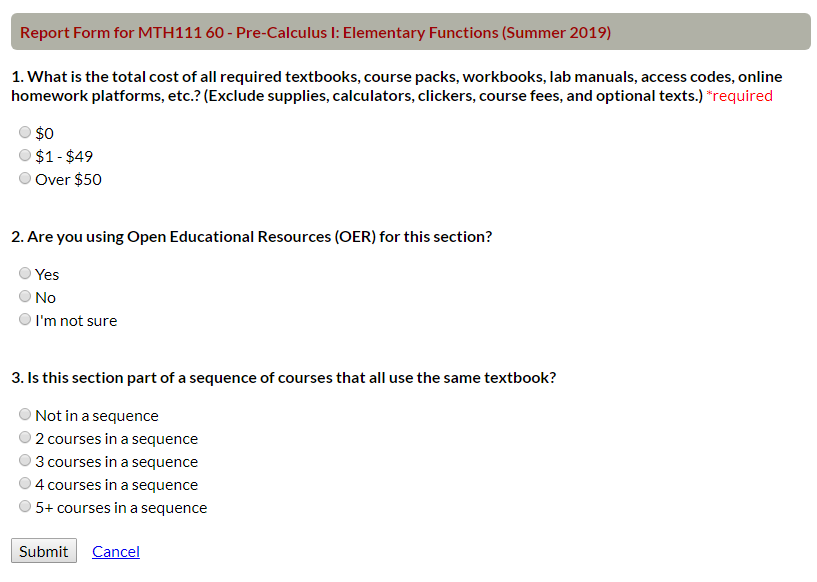
The total cost of all required course materials remains the first data point on the CSRF, as the API continues to automatically publish the No Cost and Low Cost markings in the course schedule. We reduced the number of multiple choices from seven to three, that is, to only what’s relevant to HB 2871. The total number of questions was also reduced to three, with the second asking whether the course is using OER, regardless of cost threshold. Because some courses use OER but are still above $50 for total course materials cost, they would not otherwise be captured by the cost threshold question. Having instructors report OER usage without cost considerations gives us a clean number to report when state legislators and college administrators ask how much OER are being used? After some debate, we kept the course series question because we believe that it yields valuable cost-savings data, even though reporting such data is not required by law.
We removed the “Need Help?” links to the FAQ from the CSRF because instructors were not clicking on them anyway. We removed the notes field because no one was monitoring these notes in real time, and we removed the questions about course materials, cost-savings calculations, and ISBN and URL fields since these were superfluous. These modifications produced an uncluttered form capable of collecting all the data we need while reducing the burden for instructors of completing a long form.
Our first albeit lengthy CSRF iteration was intended as a change management tool, to prompt a cultural shift in how instructors think about course materials. From my perspective it seems to have worked. By Spring 2019, the new cultural norm had become to keep textbook costs to a minimum. Instructors’ rising interest in OER is evidenced by how many of them apply for OER grants and attend OER conferences.
Sustainability Across College Silos
By early summer 2019, MHCC student services reached the final development stages of a beta release of a brand new course registration user interface with the vendor EAB Global. Unfortunately, because the project had been undertaken without involving TAT stakeholders, the No Cost and Low Cost course markings required by HB 2871 were overlooked in the initial software design. I did not become aware that a new user interface had been undertaken until June, but once the project manager was alerted to the problem, she immediately contacted EAB and explained that we could not launch the official release of the new registration interface until EAB modified the software to include the No Cost and Low Cost course markings. EAB set to work developing a short-term solution using the No Cost/Low Cost CX field that was created from the Jenzabar software enhancement fee back in 2016, but this stopgap will require extra clicks and will not be searchable by students.
Our in-house system offers tremendous benefits. It enables direct control over data inputs and outputs, so when we decided we wanted to change the question design, there was no vendor to limit our options or charge us a configuration fee; and in the rare case of a glitch (only two in the very beginning), we had our own internal IT support. At some point in the future, EAB plans to develop robust course marking functionality that rises to the level of our JICS implementation—we are just one of many customers across the country that have requested this textbook cost reporting functionality. Until EAB is able to maintain our compliance with HB 2871, however, we will prioritize our current JICS course registration interface.
Silos in higher education are nothing new. Though we came close to accidentally breaking a state law, not to mention undoing two years of carefully cultivated instructor relations, CSRF design, testing, and implementation, marketing, student training, and state reporting of cost savings data, this mishap can be appreciated as a growing pain of our textbook affordability program as institutional awareness widens across departments and administrative offices. The TAT started in 2015 as a grassroots movement among instructors, staff, and student government, operating in between the official college departments that have vested authority over college operations. We had very little administrative oversight. Over time, we grew to take on major projects such as an internal OER grant program funded by the MHCC Foundation, the creation of an official OER coordinator position, and No Cost/Low Cost course markings. The fact that compliance with HB 2871 was left out of major planning meetings of high-level administrators across the college indicates the need for an administrative home for No Cost and Low Cost course markings to secure inclusion in college planning.
The three-pronged nature of these course markings prevents responsibility for HB 2871 compliance from fitting easily into our administrative structure. The course markings in the registration system are a student service; instructors filling out the CSRF is an instructional service; and the data analysis and reporting is an institutional research service. Silos notwithstanding, finding a college administrator to take ownership of compliance with OER legislation is one of the TAT’s primary needs moving forward. The chief information officer of IT, meanwhile, has set up a safety net: these legally required No Cost and Low Cost course markings are now officially in IT’s list of mission-critical services that must be maintained over time, as programs and technologies change, and the OER Coordinator has been added to IT’s list of point people to check in with when embarking on new projects.
Recommendations
- Develop your inputs and outputs with all of your users from the very start. Determine your state reporting requirements (if any); engage your students to find out what is truly useful for them; engage your instructors through awareness campaigns and beta testing—and value their input; repeatedly remind them to fill out your forms; and make changes based on user feedback. If it does not work for them, it will not work for you.
- Determine your IT department’s project management style and how they keep track of mission-critical services. It is very likely they will need to plan ahead to allocate staff resources for your project.
- Have clearly defined policy/functionality definitions for your online forms and sanitize your inputs (i.e., ensure users cannot insert code or anything inappropriate into text fields).
- Minimize manual data entry and do not let perfection be the enemy of the good. You might have some reporting errors and underreporting; the process has a learning curve but will ultimately empower instructors to step forward into the textbook cost conversation.
- Team up with your campus bookstore, particularly when state legislation requires them to display course markings too. When working with third party bookstores, be on guard for “open wrapping” and “open washing” clauses in their contracts that might impose on your course marking workflows—providing unfettered access to free and low-cost textbooks runs contrary to their profit-driven model.
- Designate one high-level college administrator to take responsibility for legal compliance with state laws governing course markings. Keep all college administrators informed and empowered, particularly your college president. They will champion this student-centered work with the board of education and state legislators, which provides strong roots for a successful implementation.
- Be patient and be kind toward your instructors, administrators, and everyone struggling with the change. OER is breaking some very old patterns, so listen closely to the concerns of those who resist. They will probably provide something useful that you had not thought of. It is a learning process for everyone that requires skill in navigating disruptive change.
Also called Registration System, Course Timetable Software or Course Schedule Platform: a web-based application designed to aggregate key information about students, including demographic information, contact information, registration status, degree progression, grades, and other information. Some SISs assist students with enrollment, financial aid processes, and final payment for courses.
Also called attributes, designations, tags, flags, labels: specific, searchable attributes or designations that are applied to courses, allowing students to quickly identify important information to aid in their decision making and allow them to efficiently plan their academic careers. Course markings may include letters, numbers, graphic symbols, or colors and can designate any information about a course, including service learning status, additional costs, course sequencing requirements, and whether the course fulfills specific general education requirements.
Free teaching and learning materials that are licensed to allow for revision and reuse.
Similar to openwashing, refers to a practice in which open materials are “wrapped” in non-open products, often referred to by commercial companies as value-added features. The company refers to the whole product as "open", but the added features restrict users' access to the open content.
The use of the term “open” when the materials do not meet all characteristics of open (free + open licensing to allow for unlimited reuse, retention, distribution, and editing). Often used to refer to commercial products.

